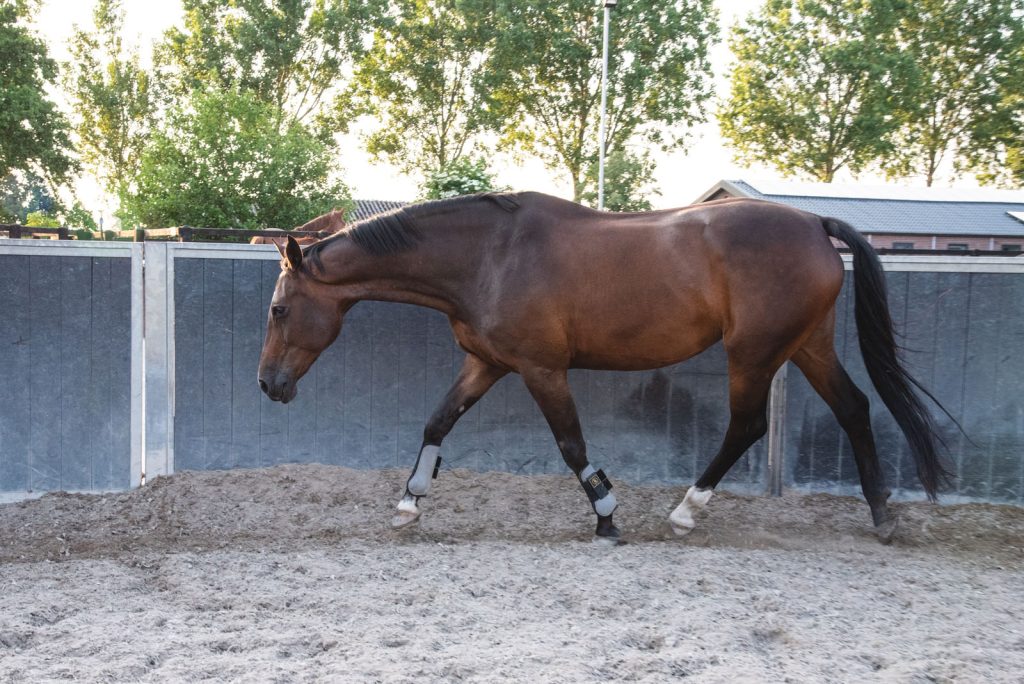A horse that doesn’t relax properly in training, struggles to pick up the canter, or keeps going disunited. Many riders recognize this as stiffness. Sometimes you even notice it while grooming: your horse reacts sensitively when you touch a certain spot. It doesn’t always have to be a visible injury, but it is a sign that something is out of balance.
Where does stiffness in your horse come from?
Stiffness in horses can have several causes. It’s often a combination of factors, with the body signaling that something is not in balance.
1. Muscle fatigue or overload
After an intense training or heavy work, a horse may be temporarily stiff. That’s part of exertion and normally goes away. But if the tension lingers, it may indicate insufficient recovery. Horses build up waste products in the muscles that are not cleared quickly enough, making them feel stiffer day after day.
2. Fascia (connective tissue) imbalance
Fascia is the tissue that runs like a web throughout the body. It connects muscles, tendons, organs, and nerves. This network responds very quickly to stress, trauma, or pain—often faster than the muscle itself. When fascia becomes hardened or “locked,” your horse feels stiff and restricted in movement, even if nothing shows on ultrasound or X-ray. Many recurring muscle tensions actually originate from this connective tissue.
3. Joints and arthritis
In older horses, or in those heavily used in sport, the joints may show wear. Joint fluid becomes less supple, and cartilage decreases in quality. The horse compensates by moving more stiffly. Often this starts subtly: trouble bending, slower to canter, or less spring in the movement.
4. Recovery after injury
After a tendon or muscle injury, scar tissue almost always forms. This tissue is stiffer and less elastic than healthy connective tissue. It limits freedom of movement and may cause surrounding muscles to become overloaded. The result: persistent stiffness or compensation in other parts of the body.
5. Overall health
Not all stiffness originates in the musculoskeletal system. A horse with lowered immunity, nutritional deficiencies, or high stress may also feel stiff. Stress activates the nervous system and keeps the body in a state of alertness, preventing the relaxation needed to keep muscles and fascia supple. A disturbed gut flora or mineral deficiency can also contribute to chronic tension in the body

What can you do for a stiff horse?
Many owners first try rest, walking, or supplements. This often brings relief but doesn’t always address the deeper cause. A massage or osteopathy treatment can release tension, but without the right building blocks, the body cannot fully recover. Especially with recurring stiffness, it’s important to look beyond the muscle itself.
Nano CellCare works at the cellular level and supports the body from within.
The therapy uses:
-
Hyaluronic acid – essential for collagen and elastin, keeping muscles and connective tissue supple.
-
Minerals from Dead Sea salt – activate recovery processes and support cell communication.
-
Vitamin C – aids in the production of strong, healthy cells.
The tiny nano-sized particles are absorbed directly through the skin or inhalation and transported to where recovery is needed. In practice, we see a horse relax already during treatment, move more freely afterwards, and recover faster. All without injections, which often come with risks.
Case: Bea
Monique noticed that her Friesian mare Bea repeatedly had problems picking up the canter. She bucked, refused to go forward, and often picked up the wrong lead. “At first I didn’t believe Nano CellCare would really make a difference,” Monique explains. “But after a few treatments Bea was much looser in her body. She used her back more, picked up the correct canter, and the bucking stopped. Even her CPL legs visibly improved. Now I have a horse that moves with joy, and that makes riding so much more enjoyable.”
Frequently Asked Questions
How quickly will I see results with stiffness?
With mild issues, you often notice improvement after 2 to 3 treatments. For chronic or recurring stiffness, a longer course of several sessions is usually needed.
Can I combine Nano with osteopathy or physiotherapy?
Yes, Nano CellCare actually enhances other therapies. Many therapists use it before their treatment, as it helps the horse release tension faster and relax more deeply.
Does this also work preventively for sport horses?
Absolutely. Nano is often used to keep sport horses supple and to help them recover more quickly from intense training or competitions.
In conclusion
Stiffness is often more than a small discomfort. It’s a sign that your horse needs support in muscles, fascia, or even at the cellular level. With Nano CellCare you give the body exactly the building blocks it needs to release tension and restore balance.
Want to know if Nano CellCare can help your horse?
Contact a therapist in your area and discover what’s possible.
Or visit the Treatment Locator

